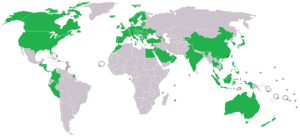A year since we last reported on it (ITA Talks Collapse, Resume in 2015), the updated ITA Agreement has finally been concluded.
Countries covered by the ITAThe ITA Agreement defines tariffs on IT products, such as monitors, at 0% – however, it has not been updated since it came into effect in 1996. Discussions about an expansion of the agreement, to cover new products that have been developed since the 90s, began in 2013 (Display Monitor Vol 20 No 27 – 46). However, these were stalled when a list of new products could not be agreed upon.
Digitaleurope now says that European Union, and 50 countries outside it, have reached a new “tariff-busting agreement” at the 10th World Trade Organisation (WTO) Ministerial Conference in Nairobi.
Once the agreement is implemented, tariffs on more than 200 technology products will be removed. These include semiconductors, game consoles, touch screens, GPS devices and – according to Digitaleurope, but not mentioned by the WTO – TV screens. The value of sales of these products is estimated to be worth $1.3 trillion annually – 10% of global trade, according to WTO director-general Roberto Azevêdo.
As much as 65% of the new products will be duty-free by July next year, and 90% by 2019. The revised agreement will result in savings of around $50 billion each year, and add approximately $190 billion to global GDP through increased trade.
The European technology industry, hoping to take advantage of the momentum of the ITA, has said that it wishes to see ‘an ambitious trade agreement on services’ concluded by the end of 2016.
Analyst Comment
We noted that the press release from Digitaleurope, which is a trade association recognised by the EU as representing the consumer electronics industry, said that TV “screens” would be included in the IT agreement. Just after press time, we got back a confirmation that TVs are not included in the agreement, and the EU told us that “TVs and Monitors are out”. We’re not sure what that means. There has been a long fight between the industry and the EU as TVs have 14% duty, while monitors were zero-rated under the current ITA agreement. Nobody could agree the differences between TVs and monitors, so there was a long legal dispute that went to the European Court of Justice and to the WTO for resolution.
Korea has an agreement that is eliminating the duty between the EU and Korea that also applied to TVs, so the Korean makers remain at a long term advantage. If the deal had include TVs, then the advantage that the Koreans have when making sets in Asia would have gone away and the Japanese and Chinese brands would have got back to “a level playing field”. The deal would have been a significant blow for Vestel, as Turkey has a special deal for 0% duty with the EU and would no longer have that advantage over other countries.
We’ll update this article as we get clarification. (BR)

